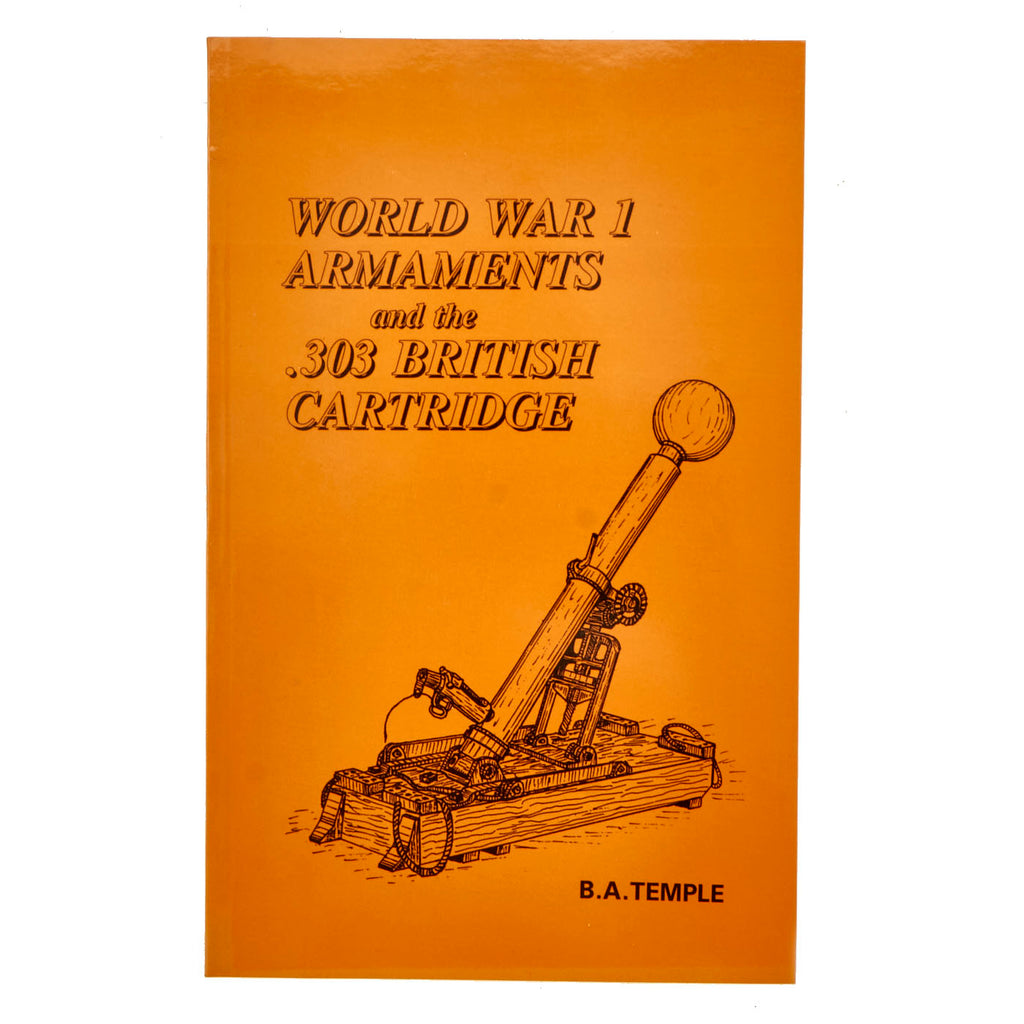Item Description
Original Book: Limited Quantity Available. “World War 1 Armaments and the .303 British Cartridge” was first published in 1995 by B.A. Temple of Kilcoy, Australia. The books measure 9 ½” x 6” and are all in lovely, unused condition.
“During the Great War, the adoption of both new and old forms of armaments for the British services occasioned the development of special patterns of the .303-inch British service cartridge for use with such specialist ordnance.
The newly introduced munitions included trench mortars, grenades, howitzers, heavy field artillery, and tanks, together with necessary ancillary items such as mortar bombs, fuzes and artillery percussion locks.
This work describes in broad outline some of the above armaments, and how the .303-inch round was adapted for the various applications; but it also gives details of other patterns of the cartridge developed for such special purposes as armour piercing, balloon and zeppelin destruction, drill instruction and tracing.
"World War 1 Armaments and the .303 British Cartridge" is therefore a book that covers the subject in a manner never before attempted. It is of special interest to students of military history, as well as to collectors generally.”
Book Introduction:
“WORLD WAR I, or the Great War as it was often called, was the first time that warfare had broken out on such a grand scale, involving as it did many European and other nations, in such diverse areas as Europe, Palestine, Mesopotamia, and East and West Africa. However, the most severe and prolonged fighting was carried on in Belgium and France, on what became known as the Western Front, which was created after the German invasion of those countries was countered, with a stale-mate resulting. This led to the construction of lines of opposing trenches stretching from the Swiss border in the East to the North Sea in the West. These trench lines were established in late 1914, and stayed more or less in the same positions for the next three and one half years or so, effectively creating a state of siege, albeit in a continuous line, rather than encircling a single fortification or town as is the usual conception of such an event.
This deadlocked theatre of war created the conditions for the introduction of specialised technical armaments on a scale hitherto unprecedented in war, thus leading to the appellation "The War of Inventions" being attached to the other names already mentioned. The Great War could thus be said to be the last of the major old style man-to-man wars, and the first of the new style or mechanised wars.
The British Army at the start of the war, though comparatively small, was highly trained in an unsophisticated way, but initially was not equipped to deal with the conditions forced upon it by this trench warfare. Its main efforts in the late 19th and early 20th centuries had been in colonial campaigning, which basically required rapid deployment of troops supported by cavalry, trans portable arms such as horse artillery and machine guns, and not much else.
The basic weapons of the British infantry in 1914 were the SMLE rifle with bayonet, machine guns of the Maxim and Vickers patterns, and one type of hand grenade. The rifles and machine guns were of .303-inch calibre, firing the .303-inch British cart ridge, which at the time was available only in ball, blank, and dummy patterns. These were -
Ball Marks VI and VII;
Blank Mark V; and
Dummy - Drill Mark III, and Inspectors Mark IV.
Fighting on the Western Front quickly created a demand for the but had been allowed to lapse re-introduction of weapons that had been developed in the past to overcome beseiged defences through lack of use such as mortars, heavy field guns, and howitzers, as well as for updating existing armaments; and new innovations such as the tank and aircraft. The result was that as the war progressed, the equipment of the British forces became more varied and extensive than it had ever been, and thus associated items such as SAA (including the .303-inch cartridge) also became equally varied, as would be expected.
The updated armaments included mortar bombs, grenades, fuzes, and artillery percussion locks; and derivations of the .303. inch cartridge developed for use with them included mortar propellant and bomb charge igniters and detonators, fuze igniters, rifle grenade propelling and detonating rounds, and percussion tubes for the percussion locks.
Other specialised employment of the round for use against the likes of kite balloons, airships, and large bomber aircraft, created tracer, incendiary, and explosive bullets, as well as armour piercing cartridges for counteracting protective armour plate in its various applications.
Also, the demands on drill cartridges for use in training by the large numbers of men called to the colours created several new varities of that type of round, resulting in a pattern that continued in use after the war as the standard drill round for many years - the Mark VI.
The aim of this study is thus to present a brief history of those armaments of the Great War that contributed to the evolution of the .303-inch British cartridge, and of the variety of ammunition of that calibre that resulted from that evolution.”
- This product is available for international shipping.
- Not eligible for payment with Paypal or Amazon




